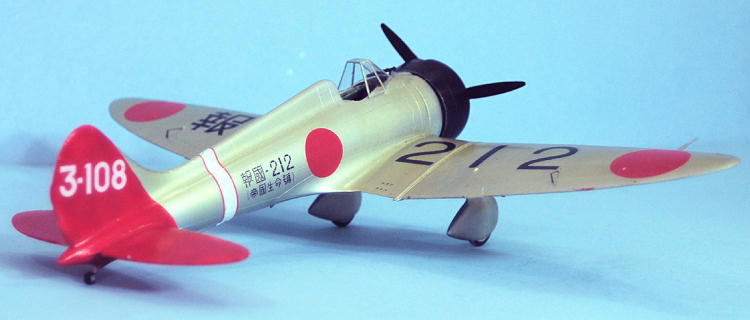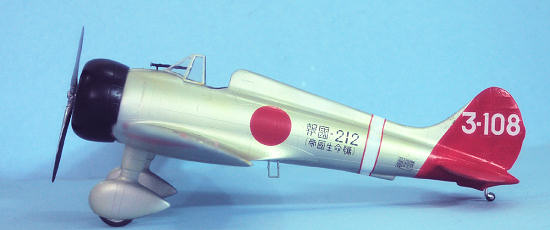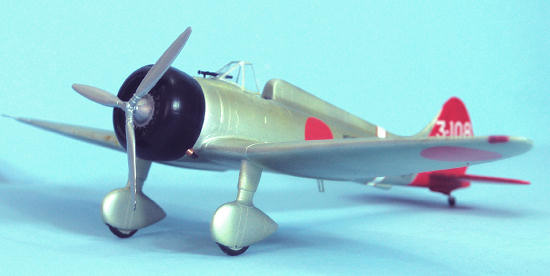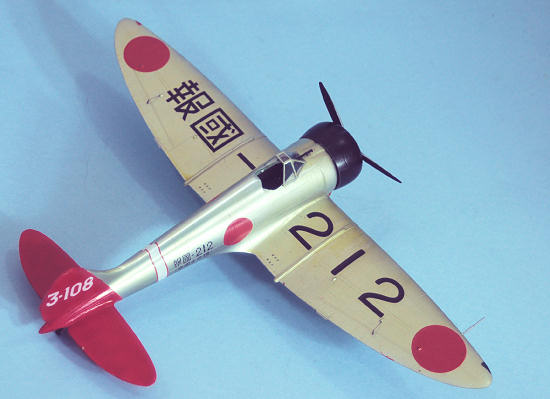Special Hobby 1/32 A5M2b Claude

One wonders why it is that
fighter pilots, who operate some of the most advanced aerial technology
available, are often so technologically conservative. Rather than leap forward,
they are generally dragged kicking and screaming into every advance made in the
art of fighter aircraft design. Nowhere was this more true than in the
transition from the biplane to the monoplane. As early as 1916, Bristol had
produced the M.1C "Bullet," 20 mph faster than the new German fighter designs
that would destroy in less than six weeks of operations over the Somme the RFC's
hard‑won air supremacy on the Western Front, and put the service through such
meat‑grinders as "Bloody April," due to the overwhelming supremacy of the German
Albatros over its opponents. RFC reluctance to operate a monoplane due to
pre‑war accidents that seemed to stress lack of structural strength in the
monoplane design led directly to these near‑catastrophic losses.
By the 1930s it
was clear that if the fighter was to retain its supremacy over its enemy, the
bomber, that new technology would have to be embraced; the fighting biplane of
the First World War style had simply run out of further opportunity for
development and improvement. Fighter pilots, used to the high‑g maneuvering of a
biplane, believed they would be at a disadvantage flying a monoplane. Thus, many
of the early specifications for monoplane fighters required the airplane to
exhibit a performance more
 akin to
that achievable with a biplane, rather than stress the strengths of the
monoplane and modify fighting tactics accordingly.
akin to
that achievable with a biplane, rather than stress the strengths of the
monoplane and modify fighting tactics accordingly.
In 1935, Jiro
Horikoshi of Mitsubishi was given the task of meeting the Imperial Japanese
Navy's imaginative 9‑Shi requirements, which had been created by LCDR Hideo
Sawai. What was revolutionary about this development was that it did not call
for a "carrier fighter" ‑ which all agreed would never meet the performance of
its land‑based opponents ‑ but a fighter per se, with maximum
performance. LCDR Sawai believed that carrier compatibility could be created
once the fighter existed.
Horikoshi's Ki.14 design,
which first flew in 1936, met the requirements through the most rigid weight
consciousness ever applied to a Mitsubishi project, using the most advanced
aerodynamic principles and construction methods. The airplane actually came out
weighing less than planned, and was the lightest fighter of its type anywhere in
the world. Horikoshi had achieved an airplane with the performance of a
monoplane, and the maneuverability of a biplane, albeit by limiting future
growth of the design due to the weight‑consciousness in its development.
Despite the light weight, Mitsubishi was proud to proclaim that
throughout its entire service, no A5M was ever lost due to structural failure.
The Ki.14 was
pitted against the Nakajima A4N biplane fighter, and no less an authority than
legendary fighter pilot Minoru Genda declared the biplane the better fighter.
However, when the rules were changed to allow climb‑and‑dive tactics as well as
traditional dogfighting maneuvers, the monoplane completely outperformed the
biplane, which could not match it in the vertical plane.
After these
tests, even the diehard Genda became a supporter.
In September 1936, the Ki.14 passed all service trials and was accepted
as the Type 96 Carrier Fighter, Model 1, or A5M1.
Armament consisted of two 7.62mm machine guns with 500 rpg, and maximum
speed was 252 mph.
Performance had
been degraded below that demonstrated by the prototype due to the use of the 580
h.p. Kotobuki 2 KAI-ko engine.
After the production of 77 A5M1s, Mitsubishi sought to restore
performance through the adoption of the 690 h.p. Kotobuki 2 KAI-3ko
engine using a 3-bladed prop, which resulted in a top speed of 265 mph.
With a deeper dorsal spine and a different cowling, the designation
changed to A5M2ko, and production began in March 1937 as the Type 96
Model 2.
 The
“China Incident” began on July 7, 1937, which lent urgency to the equipment of
operational units with the new fighter, which were first assigned to the 13th
Kokutai. The quality of the A5M2a was clearly demonstrated on its first
mission, September 19, 1937, in an attack against Chinese airfields around
Shanghai. 18 A5Ms led by Lt. Shichiro Yamashita met over 50 Curtiss Hawk IIIs
and Boeing 281s (export versions of the P‑26) in the course of two missions that
day. The Japanese claimed 26 of the defending fighters without loss! For the
first time, a Japanese airplane that was superior to its Western contemporaries
was in service. This would be clearly demonstrated in the battles over Nanking
in November and December, 1937, when the A5Ms met the I‑152 and I‑16 in combat,
flown by Soviet “volunteers,” and claimed 38 of the Soviet fighters for no loss
in their first encounter with the I-152.
While there was little to choose between the I-152 and the A5M in terms
of aircraft performance, the Japanese pilots held an edge due to superior
training, while the armored Soviet fighter was a more difficult “kill” for the
lightly-armed A5M. When the I-16 was encountered, the A5M proved to have
superior maneuverability in both the vertical and horizontal plane.
The
“China Incident” began on July 7, 1937, which lent urgency to the equipment of
operational units with the new fighter, which were first assigned to the 13th
Kokutai. The quality of the A5M2a was clearly demonstrated on its first
mission, September 19, 1937, in an attack against Chinese airfields around
Shanghai. 18 A5Ms led by Lt. Shichiro Yamashita met over 50 Curtiss Hawk IIIs
and Boeing 281s (export versions of the P‑26) in the course of two missions that
day. The Japanese claimed 26 of the defending fighters without loss! For the
first time, a Japanese airplane that was superior to its Western contemporaries
was in service. This would be clearly demonstrated in the battles over Nanking
in November and December, 1937, when the A5Ms met the I‑152 and I‑16 in combat,
flown by Soviet “volunteers,” and claimed 38 of the Soviet fighters for no loss
in their first encounter with the I-152.
While there was little to choose between the I-152 and the A5M in terms
of aircraft performance, the Japanese pilots held an edge due to superior
training, while the armored Soviet fighter was a more difficult “kill” for the
lightly-armed A5M. When the I-16 was encountered, the A5M proved to have
superior maneuverability in both the vertical and horizontal plane.
The first losses were
sustained in February 1938, when four A5ms were shot down during an air battle
that saw 8 I-152s and 8 I-16s go down over Hankow.
During the spring and summer of 1938, A5Ms were increasingly involved in
combat against both Soviet and Chinese opponents, and continued to demonstrate
the superiority of Japanese pilot training.
The first pilot to become an “ace” (defined as 10 victories by the IJN)
was Warrant Officer Kiyozumi Koga, in March 1938.
Tetsuo Iwamoto began a career that would see him become the top-scoring
A5M pilot of the China war, scoring five victories in his first combat on
February 25, 1938, over Nanchang.
The A5M2otsu entered
production in the summer of 1938, using the Kotobuki 3 engine in a modified
cowling, with an enclosed cockpit canopy.
The tradition-minded pilots did not see the new development as an
improvement, since it was heavier and had a slower rate of climb, and they
believed the enclosed canopy impaired their vision in combat.
The canopy was dropped and the windshield was extended to create a
semi-enclosed cockpit in the late production A5M2otsu, which appeared in
September 1938.
The “definitive”
A5 M4
entered production in late 1938, being primarily distinguished from the A5M2otsu
by provision of a standard radio. By that time, however, Chinese aerial
opposition was vastly reduced from what it had been a year previously.
Nevertheless, in early 1939, the A5M4 fought some of the last Soviet units over
Hankow, and emerged the winner in these battles, too.
M4
entered production in late 1938, being primarily distinguished from the A5M2otsu
by provision of a standard radio. By that time, however, Chinese aerial
opposition was vastly reduced from what it had been a year previously.
Nevertheless, in early 1939, the A5M4 fought some of the last Soviet units over
Hankow, and emerged the winner in these battles, too.
The fighting in
China produced seven A5M aces, with Tetsuo Iwamoto the leader with 14 victories.
Number 7, Petty officer Sadaaki Akamatsu scored 11. Both of these pilots
would be among the top scorers of the coming Pacific War.
Saburo Sakai also scored 4 victories flying the A5M during the China war,
bringing him to notice as the top ace he would become.
By late 1939,
the Japanese Navy had largely withdrawn from the Chinese war, and was involved
in preparation for the coming Pacific War. The limitations of the A5M were such
that a new design was called for, the 14‑Shi fighter. Basing the design on the
proven characteristics of stringent weight control and maximum usage of modern
design technique learned with the A5M, Horikoshi created his masterpiece, the
A6M Type 0 fighter.
The A5M4 would
see combat against the US Navy when the Enterprise and Yorktown
raided the Marshall Islands in February 1942, where they claimed 17 Navy bombers
shot down with four losses to Wildcat escorts.
A5M4s also formed the original fighter group assigned to Rabaul in March
1942, while the light carrier Ryujo operated A5M4s throughout the
campaign in the Philippines, and the light carrier Shoho had A5M4s aboard
as late as the Battle of the Coral Sea, where two A5Ms and three A6Ms destroyed
three of the attacking TBD Devastators on May 7, 1942.
By the end of 1942, there were no A5Ms in operational use.
For an airplane as important to Japanese aviation history as the
A5M, modelers have been badly served in getting good kits.
There was a very old Japanese kit in the 1960s which was in 1/50 scale
and had moveable control surfaces.
There was nothing else in 1/48 injection‑molded kit form until Fine Molds came
out with their very expensive models in the early 1990s.
US$70 for a kit was a bit much, and the models never sold well.
There was also a Japanese cast resin "garage kit" by T.C. Berg, which had
 nice surface
detail but required a modeler to drill out the interior to create a cockpit.
Additionally, Eagles Talon did a vacuform A5M4 in 1/48, but it was not
one of their better creations.
nice surface
detail but required a modeler to drill out the interior to create a cockpit.
Additionally, Eagles Talon did a vacuform A5M4 in 1/48, but it was not
one of their better creations.
Classic
Airframes' A5M4 was the first really good kit of this airplane, and still makes
into a good model if you find it at dealer's tables.
The kit comes on two sprues of light grey plastic, with a bag of resin
for the engine and cockpit interior, and provides decals for two A5M4s aboard
Soryu in 1939. Surface
detailing is inscribed and petite, with good fabric representation.
This new kit by
Special Hobby is the first time the A5M has been offered in 1/32 scale.
Those familiar with the Classic Airframes kit will recognize this kit as
a pantograph of the earlier kit, which is not surprising since MPM was the
company that produced the CA kit.
The kit is all plastic with some photoetch detail for levers and controls, as
well as seatbelts, but surprisingly enough, not an instrument panel.
The kit provides decals for "3‑108/Houkoku 212 Teikoku Seimei‑go,"
an A5M2otsu of the 12th Kokutai in late 1938, and
“9-122", which is identified elsewhere as an A5M4 of the 14th
Kokutai on Weichow Island in 1940.
The later A5M4 drop tank is provided in the kit, though not the earlier
A5M2 tank.
Construction is
straightforward, with the kit being quite simple overall.
The cockpit is catered for with injection-molded sidewalls, fore and aft
bulkheads, floor, seat, controls and instrument panel. I painted the cockpit
with Tamiya “Mitsubishi Cockpit Green” a nd
then assembled it. One has to do a lot of test-fitting here, because the
instructions are not too clear as to where various bits actually go, and it is
easy to end up with side walls that will not fit with the instrument panel.
There are photoetch bits for levers and such, but the cockpit opening is
small enough one can dispense with these without harming the overall look of the
model.
nd
then assembled it. One has to do a lot of test-fitting here, because the
instructions are not too clear as to where various bits actually go, and it is
easy to end up with side walls that will not fit with the instrument panel.
There are photoetch bits for levers and such, but the cockpit opening is
small enough one can dispense with these without harming the overall look of the
model.
Fit overall is
good. I assembled the rest of the model as two sub-assemblies - fuselage and
wing - then joined them and attached the horizontal stabilizers and fixed
landing gear. I needed filler along
the fuselage seams and the wing-fuselage joints and the horizontal stabilizer
joint (which has mounting tabs, a first for an MPM kit).
I assembled the cowling, which will slip over the engine, and kept both
cowling and engine off until I was through with paint and decals.
Painting:
The A5M4 is one
of those Japanese airplanes that looks much different than modelers had been led
to believe over the years. The
airplane was the first all‑metal airplane the Imperial Navy took to sea, and
they quickly learned what happens to unprotected aluminum in a saltwater
environment. The solution was to
paint the airplanes with a protective coat called "Ame Iro," one of those
clear Japanese colors like the interior blues and greens.
In this case, the paint is a clear lacquer with a yellowish tinge.
Exactly how yellow is not known, and when one looks at the black and white
photos of A5Ms, a good argument can be made that they are really silver. Special
Hobby shows the airplane on the boxart with a very light yellowish color, and
then covers their bet by calling for silver in the painting instructions.
When I did my CA A5M4, I finished it with a strong coat of Tamiya Clear
Yellow that really ended up being “gold”, as have other modelers, I concluded
after looking at the boxart here and then at available photos, that the Ame
Iro was most likely a very thin, light yellow, which is why it is easy to
miss.

I therefore
painted the model with Talon “aluminum,” then overpainted with a coat of Future
which had a small amount of Tamiya “clear yellow” in it, thinned with alcohol.
This is not an easy paint to control, and the finish is “blotchy.”
However, the photos I have of “3-108" look somewhat “blotchy,” so perhaps
the Japanese had the same problem.
It's supposed to be a very thin paint, and the airplane should look "gold" from
some angles and "silver" from others, depending on the light, which this does.
A modeler could take the easy way out here and just do the model with
aluminum paint, and no one could say it was wrong with any certainty.
The tail was
painted with Gunze-Sangyo “Red Madder” and the cowling with Tamiya “Semi-Gloss
Black.” Looking at photos, the
finish appears glossy, so after I applied the decals, I gave the model an
overall coat of Xtracrylix “Satin” clear coat.
Decals:
The decals went
down under Micro-Sol with no problem.
I liked the fact that the upper wing Teikoku Seimei‑go came with
separate pieces to limit the amount of backing, which would affect the final
finish.
I painted the
wheels with Tamiya “NATO Black,” then attached the engine, exhausts, cowling and
prop, and unmasked the windscreen.
Since photos show these airplanes well-maintained, I did not weather the model
further.
I've always
liked the A5M “Claude”, and this kit makes up into a very nice model of this
important Japanese fighter. It looks good sitting next to the Tamiya A6M2.
The model overall is a very easy project, for those with limited time to
apply to the hobby. Highly
recommended.
August 2010
Review kit
courtesy of HLJ.
If you would like your product reviewed fairly and quickly, please
contact
me or see other details in the
Note to
Contributors.
Back to the Main Page
Back to the Review
Index Page


 akin to
that achievable with a biplane, rather than stress the strengths of the
monoplane and modify fighting tactics accordingly.
akin to
that achievable with a biplane, rather than stress the strengths of the
monoplane and modify fighting tactics accordingly.
 M4
entered production in late 1938, being primarily distinguished from the A5M2otsu
by provision of a standard radio. By that time, however, Chinese aerial
opposition was vastly reduced from what it had been a year previously.
Nevertheless, in early 1939, the A5M4 fought some of the last Soviet units over
Hankow, and emerged the winner in these battles, too.
M4
entered production in late 1938, being primarily distinguished from the A5M2otsu
by provision of a standard radio. By that time, however, Chinese aerial
opposition was vastly reduced from what it had been a year previously.
Nevertheless, in early 1939, the A5M4 fought some of the last Soviet units over
Hankow, and emerged the winner in these battles, too.
 nice surface
detail but required a modeler to drill out the interior to create a cockpit.
Additionally, Eagles Talon did a vacuform A5M4 in 1/48, but it was not
one of their better creations.
nice surface
detail but required a modeler to drill out the interior to create a cockpit.
Additionally, Eagles Talon did a vacuform A5M4 in 1/48, but it was not
one of their better creations.  nd
then assembled it. One has to do a lot of test-fitting here, because the
instructions are not too clear as to where various bits actually go, and it is
easy to end up with side walls that will not fit with the instrument panel.
There are photoetch bits for levers and such, but the cockpit opening is
small enough one can dispense with these without harming the overall look of the
model.
nd
then assembled it. One has to do a lot of test-fitting here, because the
instructions are not too clear as to where various bits actually go, and it is
easy to end up with side walls that will not fit with the instrument panel.
There are photoetch bits for levers and such, but the cockpit opening is
small enough one can dispense with these without harming the overall look of the
model.